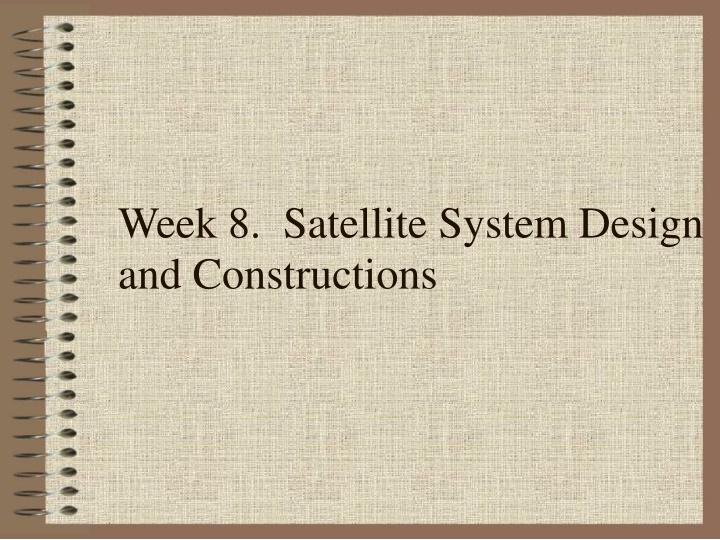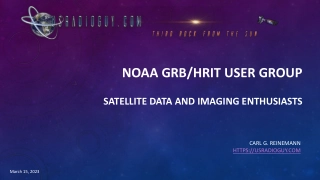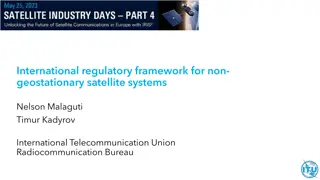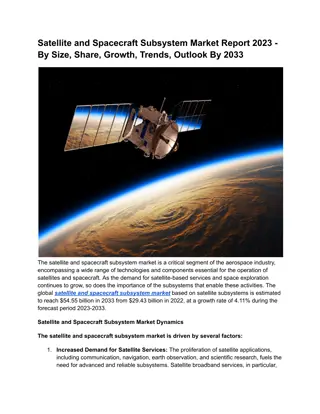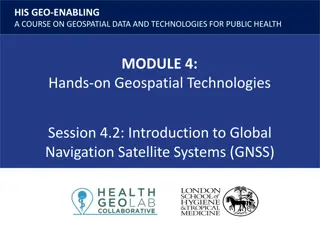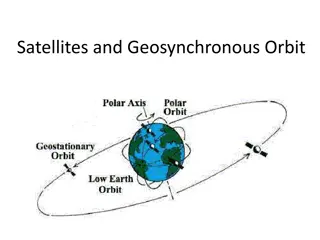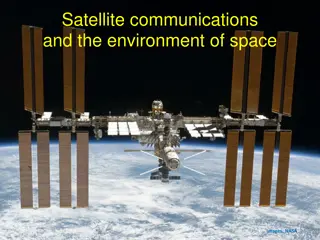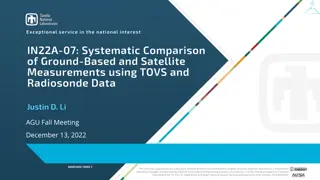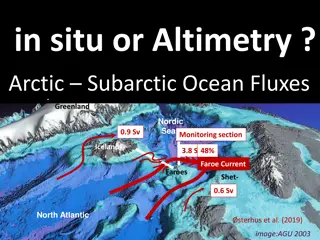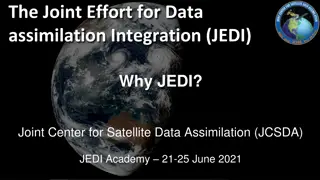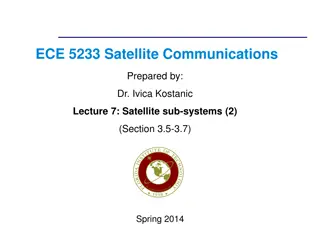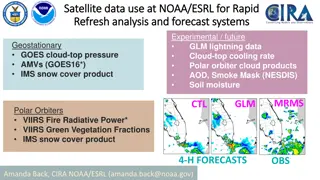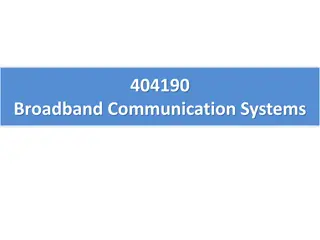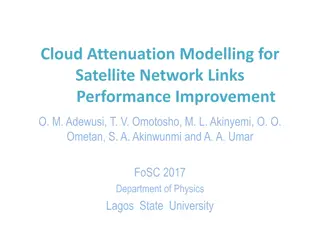Satellite System Design Considerations and Applications
Satellite system design involves various technical considerations such as optimal modulation, coding schemes, and service types. Positioning satellites in orbit faces challenges like frequency and orbit selection. Satellite limitations include high initial investments and spectrum crowding. However, satellites offer advantages like wide area coverage and compatibility with new technologies, enabling applications in communication, TV broadcasting, navigation, and more. Understanding orbital mechanics and Kepler's laws is essential in satellite system design.
Download Presentation

Please find below an Image/Link to download the presentation.
The content on the website is provided AS IS for your information and personal use only. It may not be sold, licensed, or shared on other websites without obtaining consent from the author.If you encounter any issues during the download, it is possible that the publisher has removed the file from their server.
You are allowed to download the files provided on this website for personal or commercial use, subject to the condition that they are used lawfully. All files are the property of their respective owners.
The content on the website is provided AS IS for your information and personal use only. It may not be sold, licensed, or shared on other websites without obtaining consent from the author.
E N D
Presentation Transcript
Week 8. Satellite System Design and Constructions
System Design Consideration Services or Application Selection of RF Band Finance Further technical design considerations are:- - Optimal modulation, coding scheme, type of service, permitted earth station size and complexity, shape of service area, landing rights, state of prevailing technology related both to spacecraft and ground station.
Major problems for satellite Positioning in orbit in-term of Frequency & Orbit Selection Stability Power Communications Harsh environment Interference Problem
Limitation of Satellites High initial investment New investment require in Ground Segment Short life time Spectrum crowding Regulatory aspects (landing rights etc.) Launch vehicle reliability
Advantages of Satellite Wide band capability Wide area coverage readily possible Distance-insensitive costs Counter inflationary cost history All user have same access possibilities Point to point, point to multipoint (broadcast) and multipoint to point (data collection) are all possible Inherently suited for mobile application. Compatible with all new technologies Service directly to the users premises
Applications Communication (truncking call) Teleconference Telemedicine TV Broadcasting Data communication Telemetry(TEC, remote sensing etc) Weather telecast Navigation GPS Security/Calamity monitoring Standard Time Military Remote Sensing
Contents Kepler s Laws Orbital Elements Epoch Orbital Inclination Right Ascension of Ascending Node (R.A.A.N.) Argument of Perigee Eccentricity Mean Motion Mean Anomaly Drag (optional) Apogee & Perigee Heights
Keplers Laws LAW 1: The orbit of a planet about the Sun is an ellipse with the Sun's center of mass at one focus LAW 2: A line joining a planet and the Sun sweeps out equal areas in equal intervals of time LAW 3: The squares of the periods of the planets are proportional to the cubes of their semi-major axes
Keplers First Law LAW 1: The orbit of a planet about the Sun is an ellipse with the Sun's center of mass at one focus. This is the equation for an ellipse:
Cont. Earth s orbit has an eccentricity of 0.017 (nearly circular) Pluto s orbit has an eccentricity of 0.248 (the largest in our solar system) Satellites also follow Kepler s 1st Law -But Earth can replace sun at Focus
Keplers Second Law LAW 2: A line joining a planet and the Sun sweeps out equal areas in equal intervals of time
Cont So Satellites go faster at Perigee than at Apogee Reason: conservation of specific mechanical energy; i.e., = KE + PE
Keplers Third Law LAW 3: The period of an orbit depends on the altitude of the orbit OR The square of the period is proportional to the cube of its mean distance from primary focus T2 / T2 = R3 / R a b 3 a b
Cont Low Earth orbit: 90 minutes - 186 miles, 17,684 mph Geosychronous: 24 hours - 22,236 miles, 6,857 mph Moon: 28 days (one month) - 238,330 miles, 2,259 mph
Orbital Elements The classic 'Keplerians' are the seven mathematical values which determine a spacecraft's orbit around the Earth. In practice there are additional values which are required because the Earth isn't a perfect sphere, and other anomalies.
Cont Seven numbers are required to define a satellite orbit. This set of seven numbers is called the satellite orbital elements, or sometimes "Keplerian" elements (after Johann Kepler [1571- 1630]), or just elements These numbers define an ellipse, orient it about the earth, and place the satellite on the ellipse at a particular time. In the Keplerian model, satellites orbit in an ellipse of constant shape and orientation. The Earth is at one focus of the ellipse, not the center (unless the orbit ellipse is actually a perfect circle)
Cont The basic orbital elements are... 1. Epoch 2. Orbital Inclination 3. Right Ascension of Ascending Node (R.A.A.N.) 4. Argument of Perigee 5. Eccentricity 6. Mean Motion 7. Mean Anomaly 8. Drag (optional) Note:Satellite keplerians are also distributed by NASA in a format called the NASA two- line format.
Epoch [aka "Epoch Time" or "T0"] A set of orbital elements is a snapshot, at a particular time, of the orbit of a satellite. Epoch is simply a number which specifies the time at which the snapshot was taken Orbital Inclination [aka "Inclination" or "I0"] The orbit ellipse lies in a plane known as the orbital plane. The orbital plane always goes through the center of the earth, but may be tilted any angle relative to the equator. Inclination is the angle between the orbital plane and the equatorial plane. By convention, inclination is a number between 0 and 180 degrees.
Right Ascension of Ascending Node [aka "RAAN" or "RA of Node" or RAAN", and occasionally called "Longitude of Ascending Node"] Right ascension is another fancy word for an angle, in this case, an angle measured in the equatorial plane from a reference point in the sky where right ascension is defined to be zero. Astronomers call this point the vernal equinox. Finally, "right ascension of ascending node" is an angle, measured at the center of the earth, from the vernal equinox to the ascending node.
Apogee & Perigee A few words about elliptical orbits... The point where the satellite is closest to the earth is called perigee, although it's sometimes called periapsis or perifocus. We'll call it perigee. The point where the satellite is farthest from earth is called apogee (aka apoapsis, or apifocus).
Argument of Perigee If we draw a line from perigee to apogee, this line is called the line-of-apsides (Sometimes the line-of-apsides is called the major-axis of the ellipse) The line-of-apsides passes through the center of the earth. We've already identified another line passing through the center of the earth: the line of nodes. The angle between these two lines is called the argument of perigee Where any two lines intersect, they form two supplementary angles, so to be specific, we say that argument of perigee is the angle (measured at the center of the earth) from the ascending node to perigee.
Cont In simple words the polar angle locating the perigee point of a satellite in the orbital plane; drawn between the ascending node, geocenter and perigee and measured from ascending node in direction of satellite motion.
Eccentricity [aka "ecce" or "E0" or "e"] Eccentricity tells us the "shape" of the ellipse. When e=0, the ellipse is a circle. When e is very near 1, the ellipse is very long and skinny. Mean Motion [aka "N0"] (related to "orbit period" and "semimajor-axis") Now we need to know the "size" of the orbit ellipse. In other words, how far away is the satellite?
Kepler's third law of orbital motion gives us a precise relationship between the speed of the satellite and its distance from the earth. Satellites that are close to the earth orbit very quickly. Satellites far away orbit slowly. This means that we could accomplish the same thing by specifying either the speed at which the satellite is moving, or its distance from the earth! Satellites in circular orbits travel at a constant speed. Simple. We just specify that speed, and we're done. Satellites in non-circular (i.e., eccentricity > 0) orbits move faster when they are closer to the earth, and slower when they are farther away. The common practice is to average the speed. You could call this number "average speed", but astronomers call it the "Mean Motion". Mean Motion is usually given in units of revolutions per day
In this context, a revolution or period is defined as the time from one perigee to the next. Sometimes "orbit period" is specified as an orbital element instead of Mean Motion. Period is simply the reciprocal of Mean Motion. A satellite with a Mean Motion of 2 revs per day, for example, has a period of 12 hours. Sometimes semi-major-axis (SMA) is specified instead of Mean Motion. SMA is one-half the length (measured the long way) of the orbit ellipse, and is directly related to mean motion by a simple equation. Typically, satellites have Mean Motions in the range of 1 rev/day to about 16 rev/day
Mean Anomaly [aka "M0" or "MA" or "Phase"] Now that we have the size, shape, and orientation of the orbit firmly established, the only thing left to do is specify where exactly the satellite is on this orbit ellipse at some particular time. Anomaly is yet another astronomer-word for angle. Mean anomaly is simply an angle that marches uniformly in time from 0 to 360 degrees during one revolution. It is defined to be 0 degrees at perigee, and therefore is 180 degrees at apogee.
Drag [aka "N1"] Drag caused by the earth's atmosphere causes satellites to spiral downward. As they spiral downward, they speed up. The Drag orbital element simply tells us the rate at which Mean Motion is changing due to drag or other related effects. Precisely, Drag is one half the first time derivative of Mean Motion. Its units are revolutions per day per day. It is typically a very small number. Common values for low-earth-orbiting satellites are on the order of 10^-4. Common values for high-orbiting satellites are on the order of 10^-7 or smaller.
Kepler Orbital Parameters (Kepler Elements) - right ascension of ascending node i - inclination of orbital plane - argument of perigee a - semimajor axis of orbital ellipse e - numerical eccentricity of ellipse T - epoch of perigee passage 0 Ref: www.amsat.org/amsat/keps/kepmodel.html#argp www.amsat.org/amsat/ftp/keps/current/amsat.all
